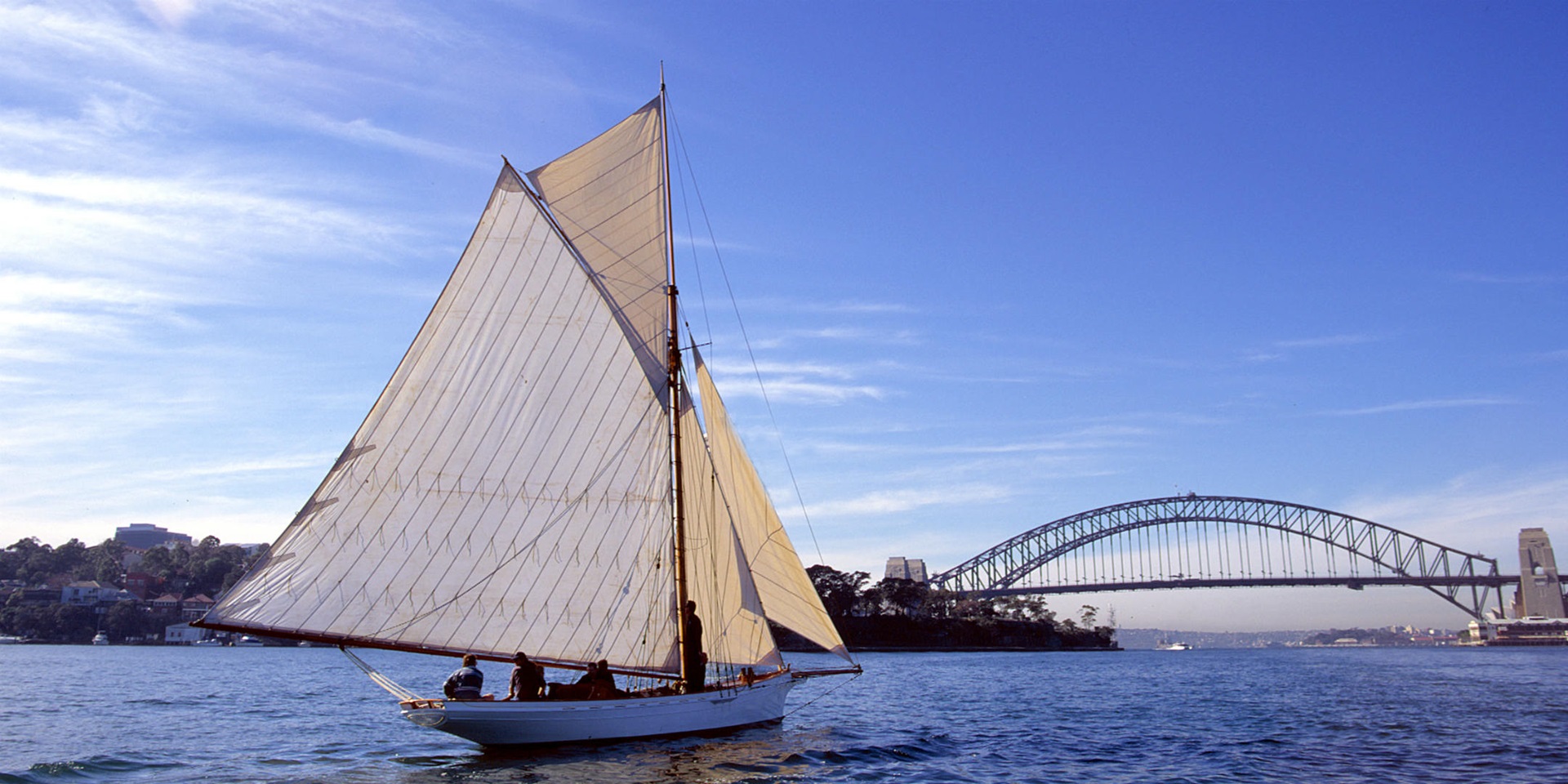
Driven by the wind
Australians have nicknames for their favourite winds: The Southerly Busters burst in with their damaging gusts; a Black Nor’Easter is an angry strong sea breeze; while the Fremantle Doctor is consistently on time, relieving the heat each day over in the west. Australians make good use of these forces of nature out on the water. We can sail with the best and have done so for a very long time.
The winds which are the hallmarks of Australian summers have brought us huge recreational pleasure, taking us to beaches, bays and coves for cruising and racing around the buoys, or around the coast, to test ourselves against the wind and each other. These winds have taught us well, as Australians have played in and explored their country’s coast and waterways extensively by sail and our sailing sportsmen and women have had enormous success at home and internationally.
Wind is simply moving air powered by the sun but moving in complicated ways. Hot days, cold nights, temperature differences between the land and sea, changing seasons, uneven landforms: it is all vastly variable and nothing is fixed. Mastering those variables is how sailors get about on the water with confidence, and how they have won (and lost) races.
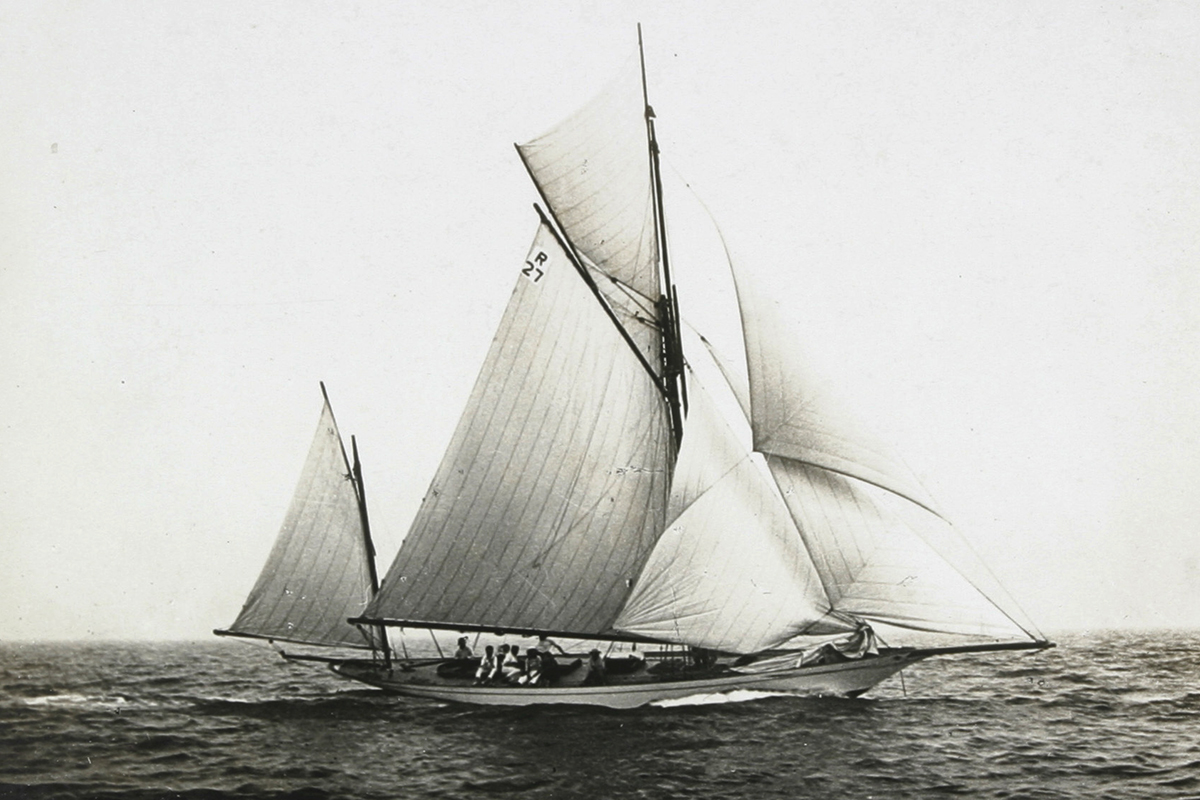
SAYONARA with its original yawl rig. HV000367.
The first sailors
In the Torres Strait Islands, the large double outriggers have been an integral part of their culture for over 2000 years. When the European ships travelled through these seas, the explorers sighted the outrigger canoes with their characteristically large sails. It was an unfamiliar type of watercraft to the Europeans, but they recognized the speed and capability of the outriggers.
Torres Strait Islanders have different names for their winds: Nagai is when it is calm, while the Sager is a wind which brings choppy seas, Zei is a cold breeze and Kuki is a cyclone.
In Arnhem Land, the Maccassins first came to trade around 500 years ago. Their perahus crafts had sails too. The Maccassins showed the northern Aboriginal communities how to make dugout canoes with sails; a watercraft that Arnhem Land communities still make to this day.
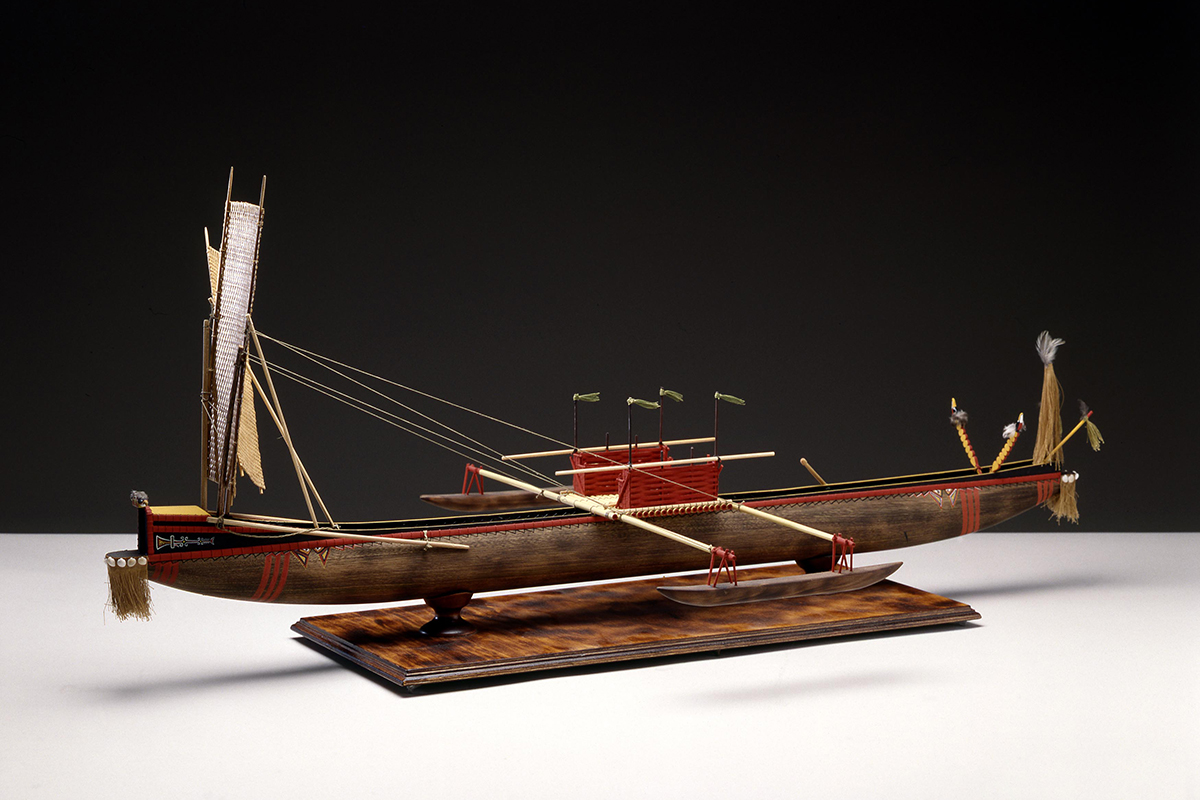
Model of a canoe with mat sails from Mabuiag Island, Torres Strait. ANMM Collection 00004428. Model maker: George Crowley.
Sailing and Australia
The first colonial sailing in small craft took place soon after the First Fleet arrived in 1788, out on Sydney Harbour and up the Parramatta River in cutters and long boats.
Soon after, another celebrated sailing adventure happened: The Tom Thumb headed south for a short exploratory trip with George Bass and Matthew Flinders, but the pair misread the conditions and ended up well past their objective. Not a good start. The pair returned to the colony and ever since, many more of us have done something unplanned, heading off from the shore, out on our own early sailing journeys. After all, experience helps the sailor read and master the wind.
Australians have set speed records, long distance endurance marks, pioneered technology, created beautiful boats, designed and made hi-tech yachts, won Olympic gold and world championships
Sailing in the colonies
Recreational sailing started young in the infant colonies and was popular by the 1830s. Workboats were enlisted to prove who was best on the water and became race boats once or twice a year. Regattas were large events for rowing craft but grew to include the odd sailing event. Some of the earliest sailing races can be traced back to Tasmania and Sydney. Other colonies followed suit as they become more established owing to Australia’s many good bays and harbours for sailing.
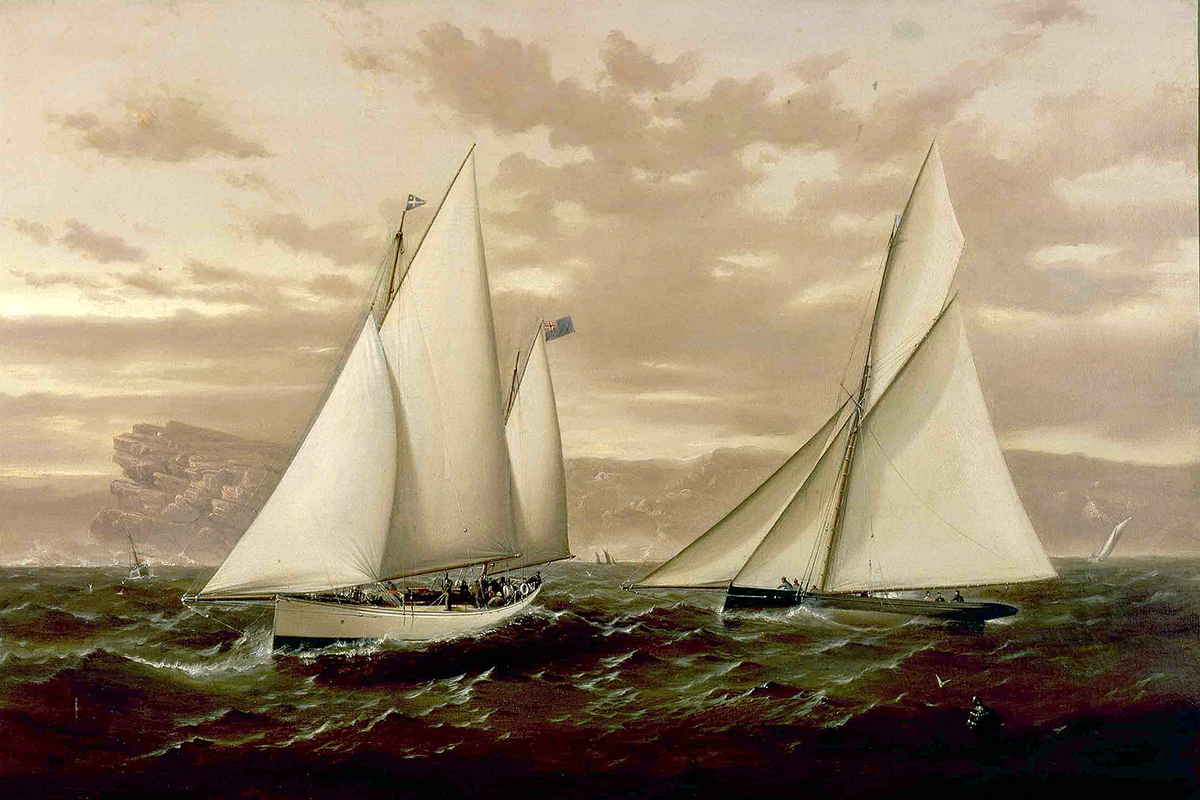
HRH PRINCE OF WALES sailing Sydney Harbour. The painting depicts two yachts racing on Sydney Harbour turning around a buoy. c.1901. ANMM Collection 00000910.
Naturally, the creation of sailing clubs was not far behind. Again, it was Tasmania heralding the trend early, with Derwent River being home to one of the first clubs, followed quickly by one further north on the Tamar River. New South Wales, Victoria and South Australia soon caught on.
The establishment of a major club in Sydney can be tracked in the press over a number of years, but once it happened, it hastened more sailing, more regattas, and more clubs being established. By then sailing isn’t just popular in the emerging capital cities, it was widespread: there was racing at Goolwa and Millangm lakes in South Australia. Even the pearling fleet in the far North Queensland got in on the act.
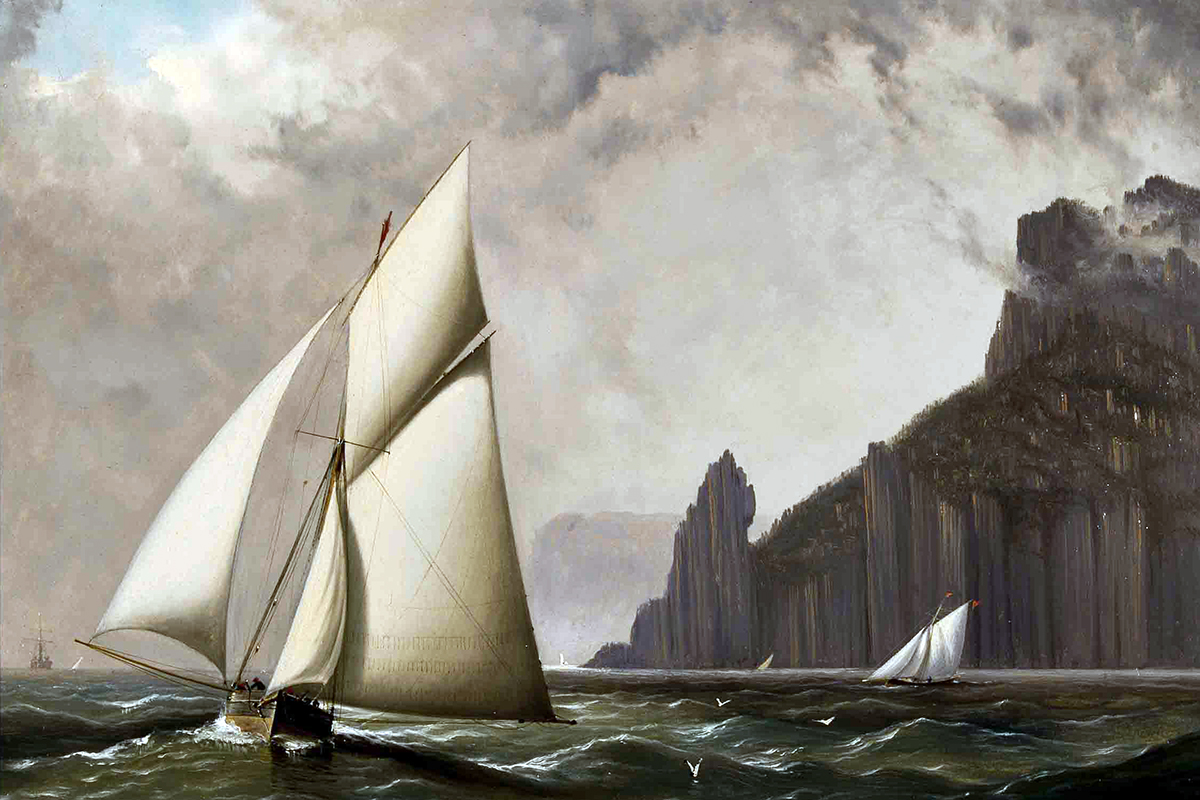
This untitled painting, known as 'Sailing, Storm Bay, Tasmania', shows Cape Pillar in the background and is attributed to Haughton Forrest. ANMM Collection 00008553.
Sport of the working class
In the later 1800’s, intercolonial yachting events were a showcase for the best representative that the participating colonies could send. Even then they knew winning races required having the most cutting-edge yacht available.
In 1888, the Intercolonial Regatta at Port Philip featured three large yachts exclusively designed and built in Australia to the latest International Rule: Victoria’s Iduna, New South Wales’ Era and Volunteer. All three were designed by Sydney naval architect Walter Reeks. Alongside the local craft of the racing circuit at the time was a New Zealand entrant, Robert Logan’s Akarana, the first deliberate challenge by a New Zealand craft to Australia’s sailing supremacy.
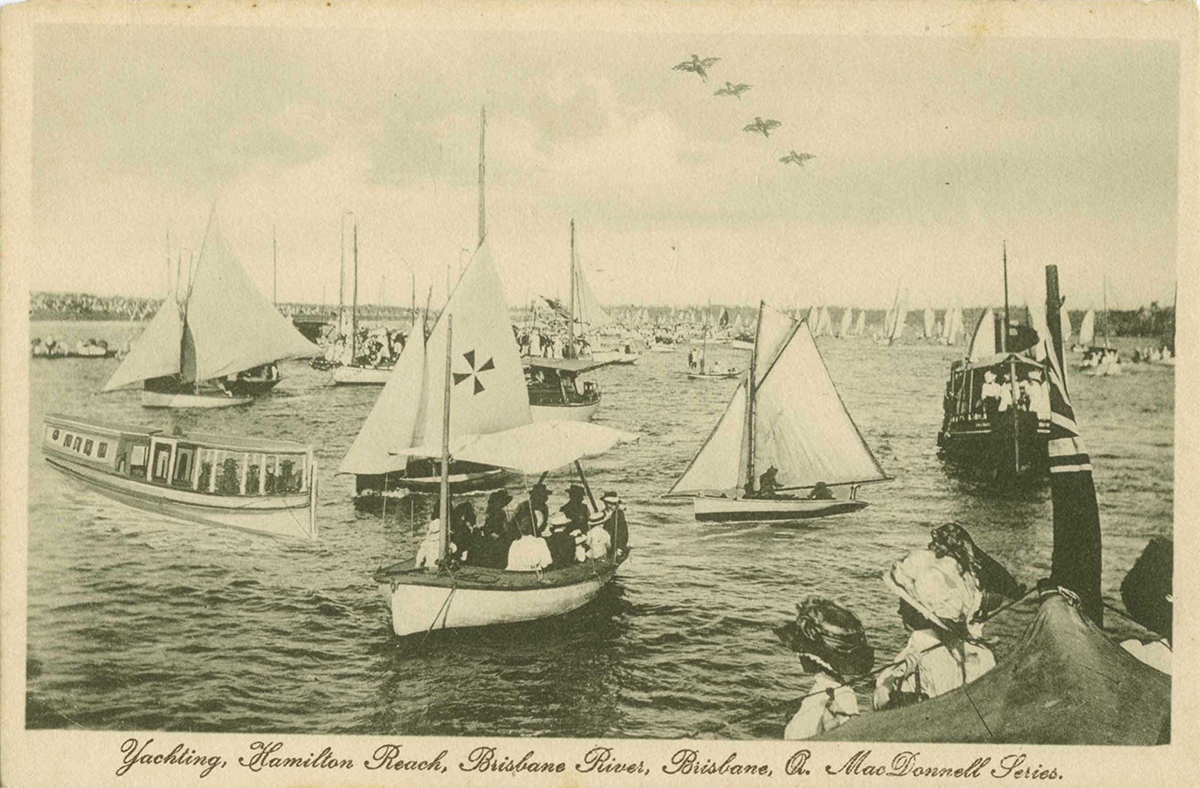
Yachting, Hamilton Reach Brisbane River, Brisbane. c.1900. ANMM Collection 00009338.
In Victoria, couta boats and other working craft were beginning to evolve into racing craft, while in Tasmania the ketches were racing for the glory of being the fastest on the Derwent River. Tasmanians had also begun creating their own divisions and types, such as the 21 Foot Waterline class. One of these, Clutha, went overboard on the overhangs, it measured 40 feet overall. By the 1860s, in Sydney, technology was on show when Richard Hartnett designed the unique, true double- ended Australian. Balanced and fast Australian was configured to measure much shorter than its true length, so its handicap was very generous. Australians around the country showed their hand early that they were ready for ingenuity and rule exploitation if it could be found, and kept at it until it paid off handsomely in 1983 at the America’s Cup.
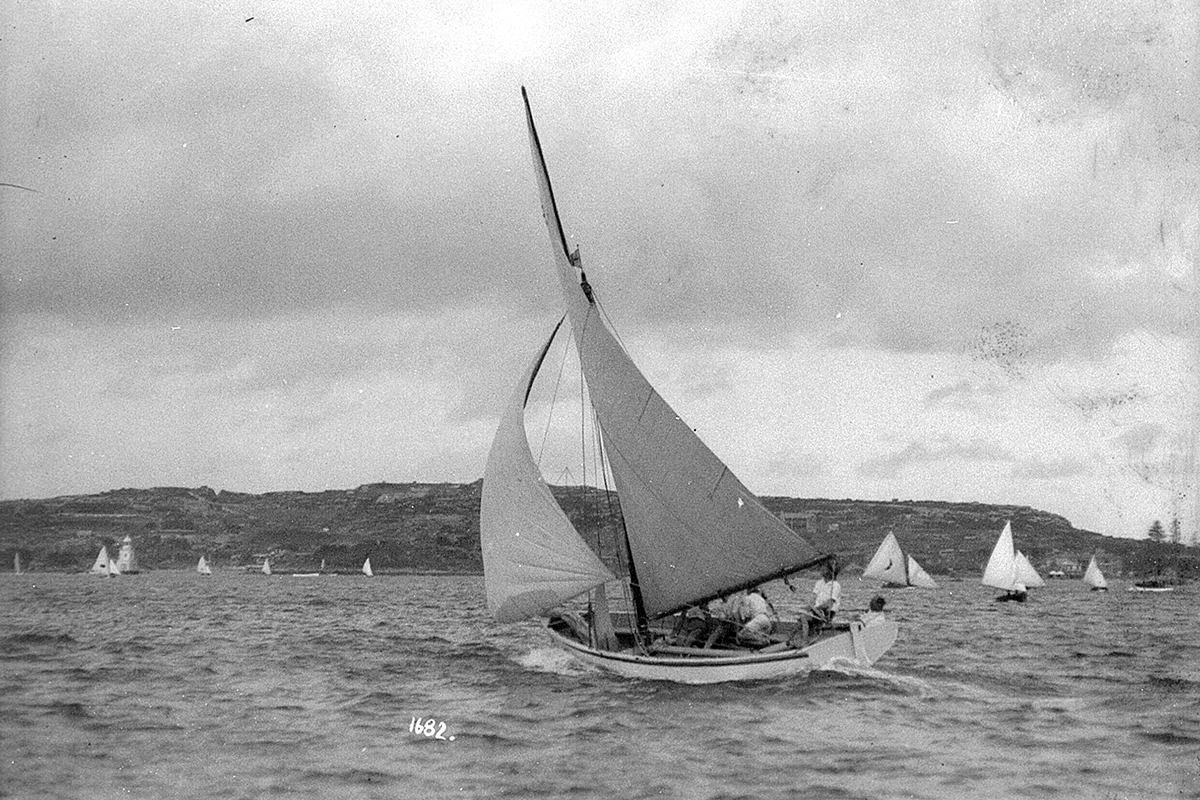
A couta type yacht sailing north on Sydney Harbour with South Head and Watson's Bay in distance. ANMM Collection 00011020. William James Hall.
In Queensland, Western Australia and South Australia they raced yachts, open boats and dinghies on their major city and regional ports. At the time coastal shipping was still a primary transport and trade route, and the ports were thriving places. Working harbours were the norm, and the workers took to sailing too, none better than the men who raced on Sydney Harbour in 22 and 24 foot long open boats with their extraordinary sail areas. They took them up in Queensland too, but an entrepreneur called Mark Foy brought the concept to the people as a spectator sport with the 18-foot skiffs and the Sydney Flying Squadron, creating the now iconic class known the world over.
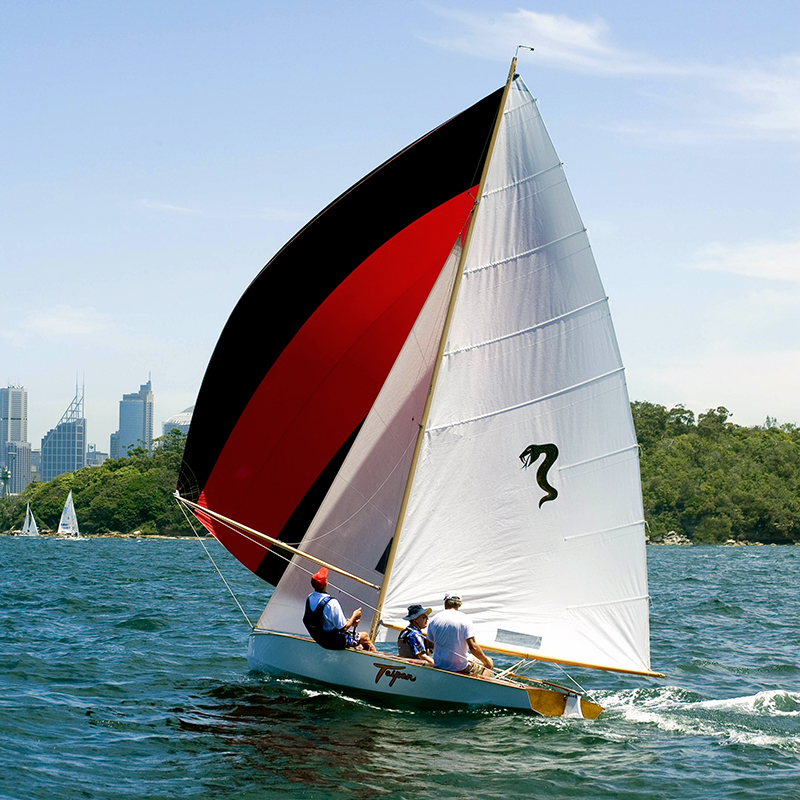
TAIPAN was a revolutionary craft in the 18 foot skiff sailing class designed and built by Bob Miller in Queensland in 1959. ANMM Collection 000000083. Image: Andrew Frolows/ANMM.
Women got on the water too, they had been quick to take on rowing and soon added sailing to their qualifications. Irene Pritchard made her name on Sydney Harbour with her 8 footer Zephyr.
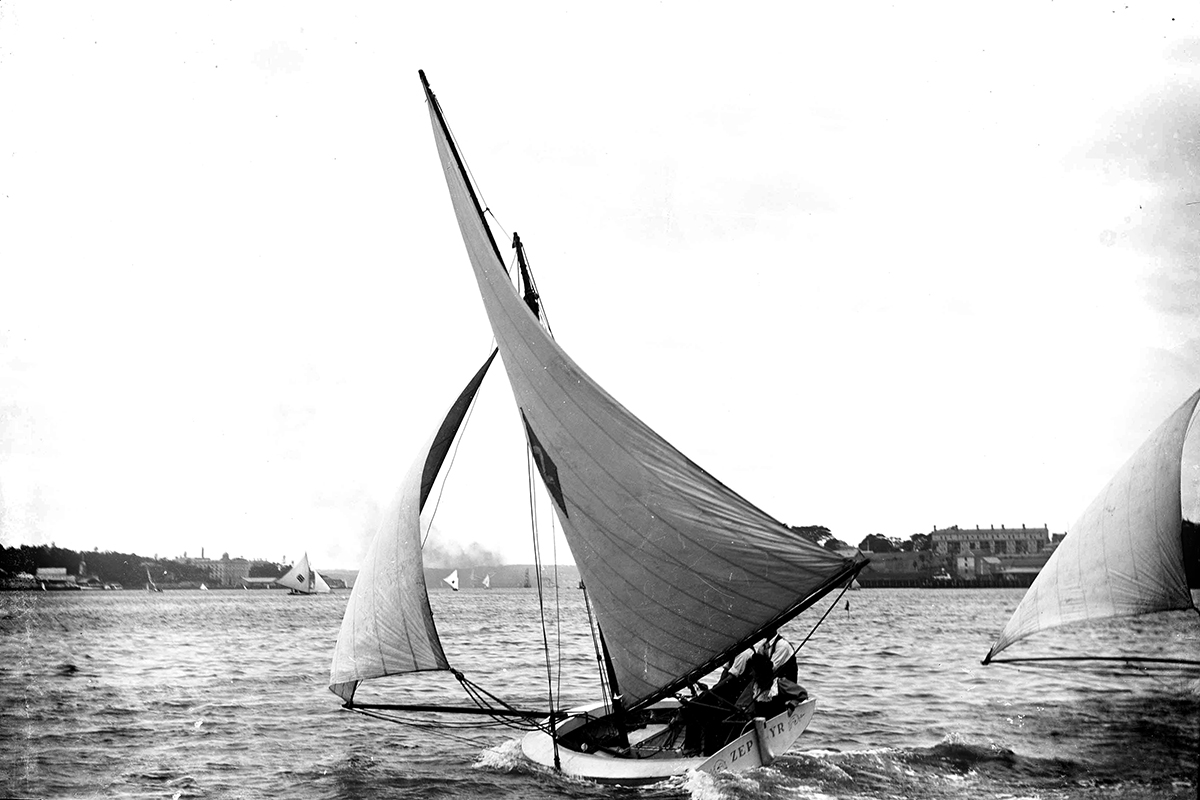
Yacht ZEPHYR on Sydney Harbour. ANMM Collection 00002619. William James Hall.
Cruising is sometimes in the shadow of racing. It makes a slower start perhaps, but private voyages under sail feature set high standards. Prime examples were Ben Boyd with his big armed schooner Wanderer and Victoria Governor Lord Brassey’s yacht Sunbeam. Iduna, although successful in racing was built primarily to cruise the regions outside of Port Phillip, while another Reeks design, Miranda went to Hobart and back, a major adventure for the time. Era, Reek’s biggest cutter was set up to cruise as well, and it was armed too.
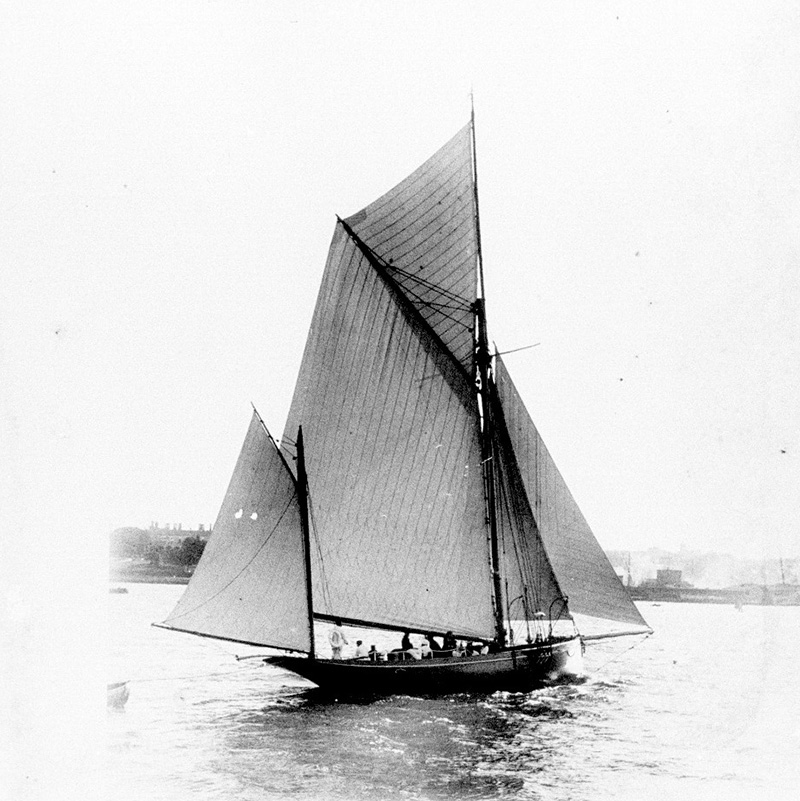
Yawl, probably ERA, off Farm Cove, Sydney Harbour. ANMM Collection 00002476. William James Hall.
Akarana managed to win races in 1888 and 1889, and was soon followed by more New Zealand connections that have grown. The colony across the ditch has more than just a thread in our story too. Members of the Green family of boat builders from Milson’s Point went across to New Zealand and built some highly successful racing yachts that owed a lot to the inspiration and even shape of that amazing yacht called Australian. William Holmes, from Devonport in Auckland, became a builder in McMahons Point on Sydney Harbour. When the Logan Bros Rainbow came across from Auckland to race and beat the best on Sydney Harbour in 1899 and 1900, some of the havoc it created was due to Holmes being on board, especially when he and his skiff mates rigged a lightweight reaching sail in an unconventional manner to steal the second race (pre-empting the Code Zero sail of the late 1990s by almost 100 years!).
After a century of sailing, Australia was ready to go further…

39-foot gaff cutter AKARANA. ANMM Collection 00001600. Image: Andrew Frolows/ANMM.
Riding the waves of change
By the end of the following century, everyone knew who we were, and were vying to borrow Australians for their team. Boatbuilder and open boat champion George Ellis started the trend early and went to Canada in the early 1900s, showing them more than a thing or two on how to sail.
Back home yachting again took a lead role: In 1901 Alfred Gollin challenged the best yachts on Sydney Harbour to race his magnificent Sayonara, but the race was delayed until 1903 out of respect to the passing of Queen Victoria. He sailed to New South Wales, defeated the New Zealand built Bona and donated a cup along the lines of the famous America’s Cup. Called the Sayonara Cup, it was the premier event, an exclusive senior club contest which the public went out to watch, and the Victorians had their hands on the cup with fine sailing on many occasions.
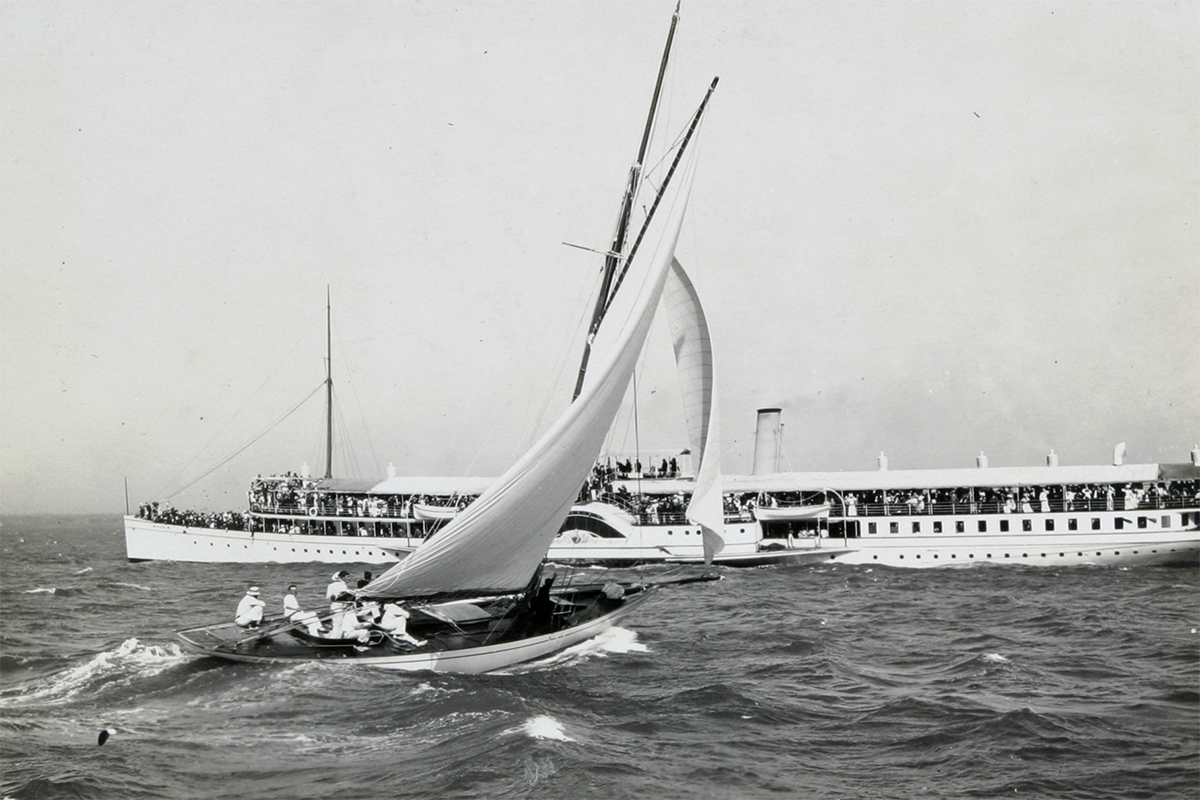
SAYONARA was built for Melbourne businessman George Garrad in 1897, to a design by William Fife III from Scotland, considered the most important naval architect of the period. HV000367.
The Sayonara Cup soon led to other cups and regattas throughout the different levels of national sailing. The Northcote Cup for smaller yachts followed, then the Forster Cup which inaugurated two decades of keen interstate racing throughout the country. The Forster Cup was one of the first Australian created classes, whose origins came from the Victorian workboats. The 21-foot restricted class was a show case for talent in sailors, designers and builders. Teams from Tasmania, Victoria, New South Wales and Queensland took it to heart with proud representatives from each state doing their best in design, building, crewing and helming. It led to the design of the smaller Cadets, racing for their states in the Stonehaven Cup – an event and class still held today.
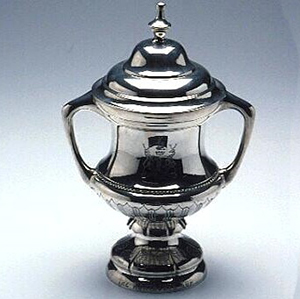
Northcote Cup Yachting Trophy. ANMM Collection 00031720. Maker: W Kerr and Sons.
World Wars I and II bookend a strong national sense of pride that prevailed in the 20s and 30s, thanks to the interstate contests in dinghies, skiff classes and yachts. Post-1945, the wider world was coming to Australia.
The International 12sq.m. Sharpies gained a foothold, eventually producing our first Olympic medal, West Australian Rolly Tasker’s silver in Melbourne in 1956. Tasker also became our first world champion in 1958, sailing in the Flying Dutchman class.
The Australian version of the Moth class gradually became the accepted version worldwide, and in good old Australian fashion, someone saw an opportunity to improve that 12 sq.m .‘heavyweight’ gaff rigged planked Sharpie into a lightweight Bermudian rigged plywood flyer. We finally had our own version of this class suited to our exciting sailing conditions and Europe cottoned on eventually.
The New Zealand connection has another twist in the late 1950s and into the 1960s. An intriguing swap the two countries managed was for Australia to lose architect John Spencer to New Zealand, but in exchange, we got the scientist and weather guru Frank Bethwaite, from New Zealand. Both pioneered lightweight plywood planning dinghies ahead of the rest of the world with Spencer’s Cherubs, Javelins and Flying Ants. Bethwaite dominated the NS 14s, and that lead to the Taser, an International class. Frank’s son, Julian, took it further with the challenge of sailing the outrageous, overpowered Australian skiff designs. These became truly international with the Olympic 49er class, being a total Bethwaite product.
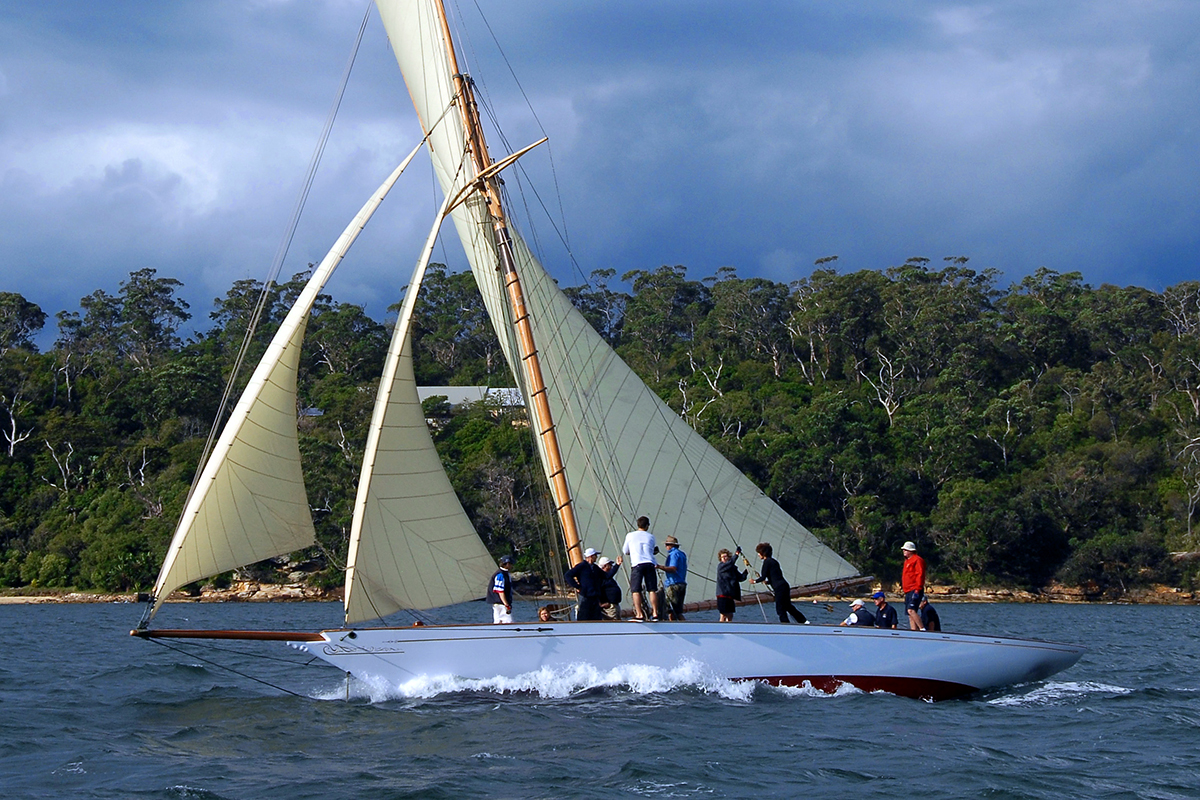
SAYONARA was built for Melbourne businessman George Garrad in 1897, to a design by William Fife III from Scotland, considered the most important naval architect of the period. HV000367. Andrew Frolows/ANMM.
Ocean racing
Ocean racing had begun prior to Federation with various coastal events, but in 1907, the Victorians famously took on the Bass Strait but some did not hurry to repeat the experience. Racing for the Rudder Cup, they began Australia’s oldest ocean race. This first race was won by Thistle, a1887 Walter Reeks designed yawl, skippered by Edgar Newland with a crew that included his wife and daughter. Mrs Newland found the conditions so rough that she refused to relinquish the Rudder Cup, hoping to stop anyone from attempting such a dangerous race again. However, the Melbourne to Devonport race is still on the calendar and is the fifth oldest organised ocean yacht race in the world.
![THISTLE. From an album with photographs of vessels including RYS SUNBEAM, THISTLE, RYCV GITANA, AWANEII, RMYC MYSTERY, WENONAH, RYCV CRUSADER and QUEENIE. ANMM Collection ANMS0328[007].](/-/media/anmm/images/blog-content/digital-stories/sailing/anms0328007_01_1200x1200.jpg?h=1200&w=1200&la=en)
THISTLE. From an album with photographs of vessels including RYS SUNBEAM, THISTLE, RYCV GITANA, AWANEII, RMYC MYSTERY, WENONAH, RYCV CRUSADER and QUEENIE. ANMM Collection ANMS0328[007].
Ocean racing became widely established after World War II and races from the major ports were established around the country. In Western Australia, the race to Bunbury lasted a year before they thought it would be an even better event to make the course Bunbury and return. Races beyond Cape Leeuwin became tough encounters, and they all played a part in developing a strong regional fleet of craft designed and built locally, with Len Randell becoming their own homegrown naval architect and yacht designer.
In Queensland they headed north for the Brisbane to Gladstone race, over in South Australia they went west to Port Lincoln, and in Sydney, it was south to Hobart. A cruise that became a race before anyone had begun to get their yachts victualled led to an event that captured the public’s interest and grabbed the sailors’ instincts for a challenge. The Rolex Sydney to Hobart is now a national event that is up there on the public calendar with the Boxing Day Test. It has International standing and set us on course for the first of two major international triumphs. Yachts come to Australia to take on the Sydney to Hobart: some as an adventure, but others were deadly serious, such as Comanche, which has competed twice. During their first race, Comanche placed second to reigning winner Wild Oats, the yacht which in recent years has become a household name thanks to the Sydney to Hobart.
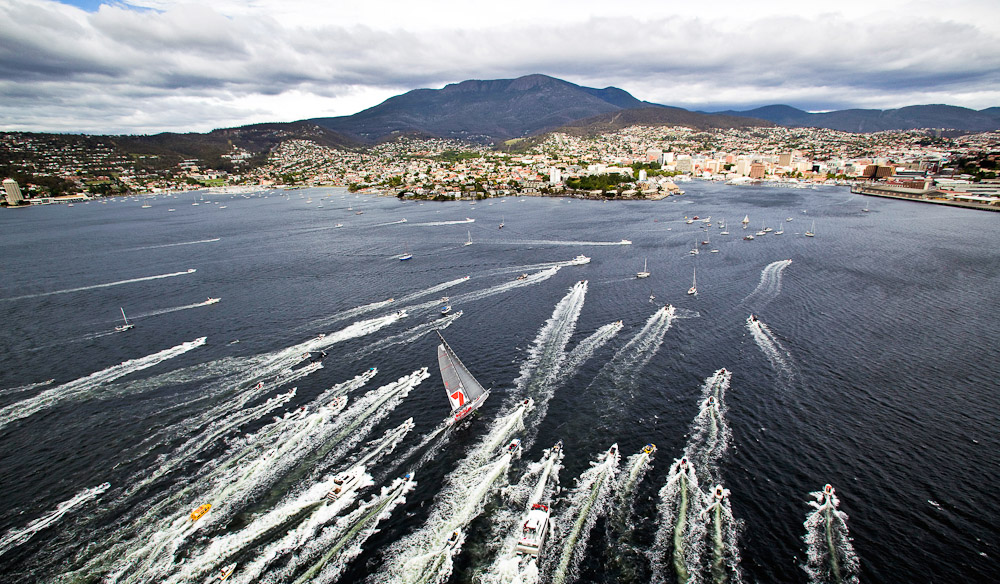
A royal welcome for WILD OATS XI in Hobart for the Rolex Sydney to Hobart Yacht Race. © ROLEX/DANIEL FORSTER.
Admiral’s Cup to the America’s Cup
In 1965, three ocean racing yachts went to the Admiral’s Cup, and caught the favoured United States and English teams by surprise, coming second in their cherished event. The United States and English teams did not take heed of this warning shot, Australia came back in 1967 with an impressive team of yachts (including Mercedes III whose hull shape was created a young Bob Miller). Australia won in the most emphatic fashion: Mercedes was the champion boat, Balandra and Caprice of Huon the next two top individual yachts and Australia won by over 100 points, a feat that has never been repeated.
Miller went on to create Apollo, a yacht that was so legendary that, when it was sadly lost on reef up north, a wake was held for the boat in Sydney at its home club, the Cruising Yacht Club of Australia. Apollo had done its job by then, none more important than giving its flamboyant owner Alan Bond a taste of success and International racing. So he took on the America’s Cup, with Miller as his designer.
At that point, Australia had shown we meant business in the America’s Cup, in particular with the two Packer sponsored challenges. In 1962, the Americans got a wakeup call when a very competitive Alan Payne designed and Halvorsen built Gretel entered the race for the cup. Gretel was crewed by sailors from different states and rode a wave past the United States’ Weatherly to win the second race, with the American president watching from a destroyer.
It didn’t stop us, in 1970 Gretel II twice crossed the line ahead of the Intrepid and showed we were again on par with the United States team in the technology stakes with Gretel II’s airframe quality mast and different hull proportions. Miller recognised that a technology lead was the direction to follow, but had to earn his stripes the hard way. His first go with Southern Cross was different looking but an indifferent performer. Miller then returned under the name Ben Lexcen and Austraila put him back on course. In 1980 a revamped Australia with a tricky mast showed that the US was vulnerable to a surprise.
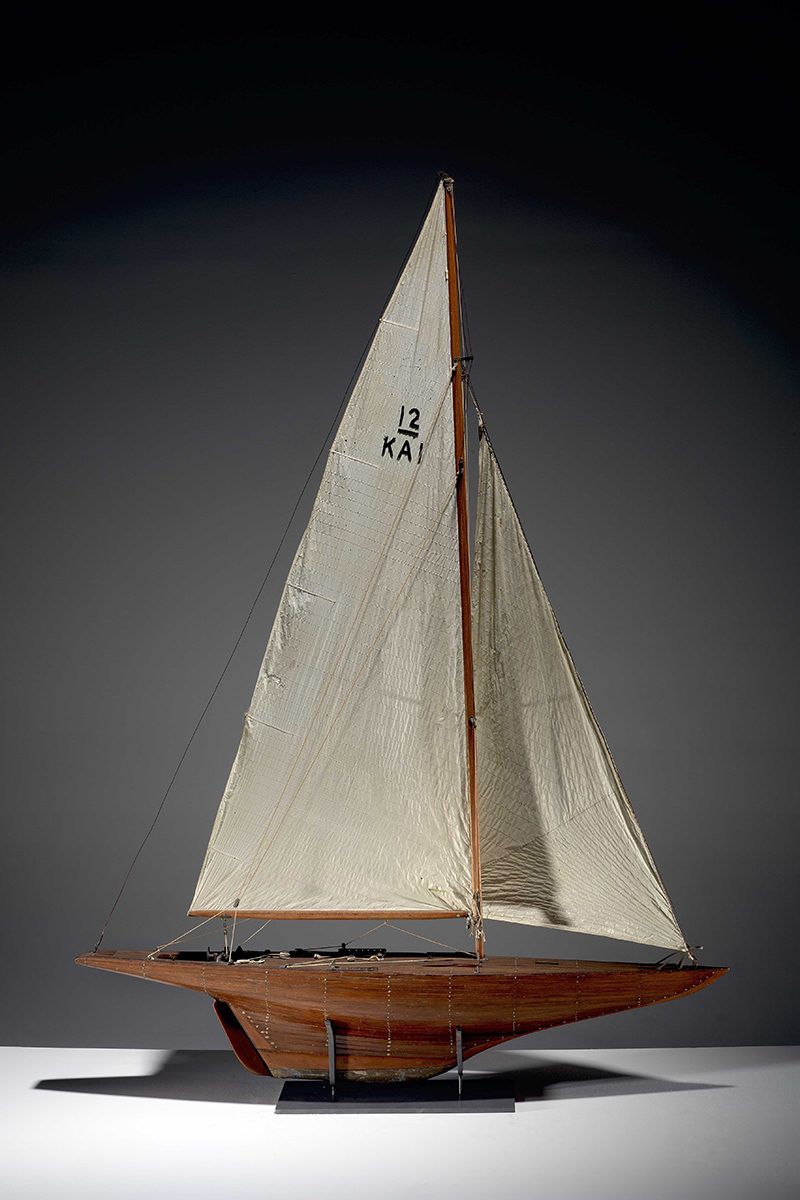
Amateur wooden planked model of the America's Cup Challenger yacht GRETEL. ANMM Collection 00038316. Maker: David Williams.
Bond was learning too, and for both Bond and Lexcen, it came together in 1983 with Australia II. Lexcen had his masterstroke, springing the winged keel on everyone. Bond and the team around him knew how much more was needed to be the best of the best and optimised everything they could, including their off-water boardroom and negotiating skills. The best ever series of races was crowned with the race of the century, when Australia II came from behind to win the last race and brought the America’s cup to Fremantle, ending the longest winning streak in any sports history. This was worldwide news and remains as one of the Australian’s finest sporting achievements.
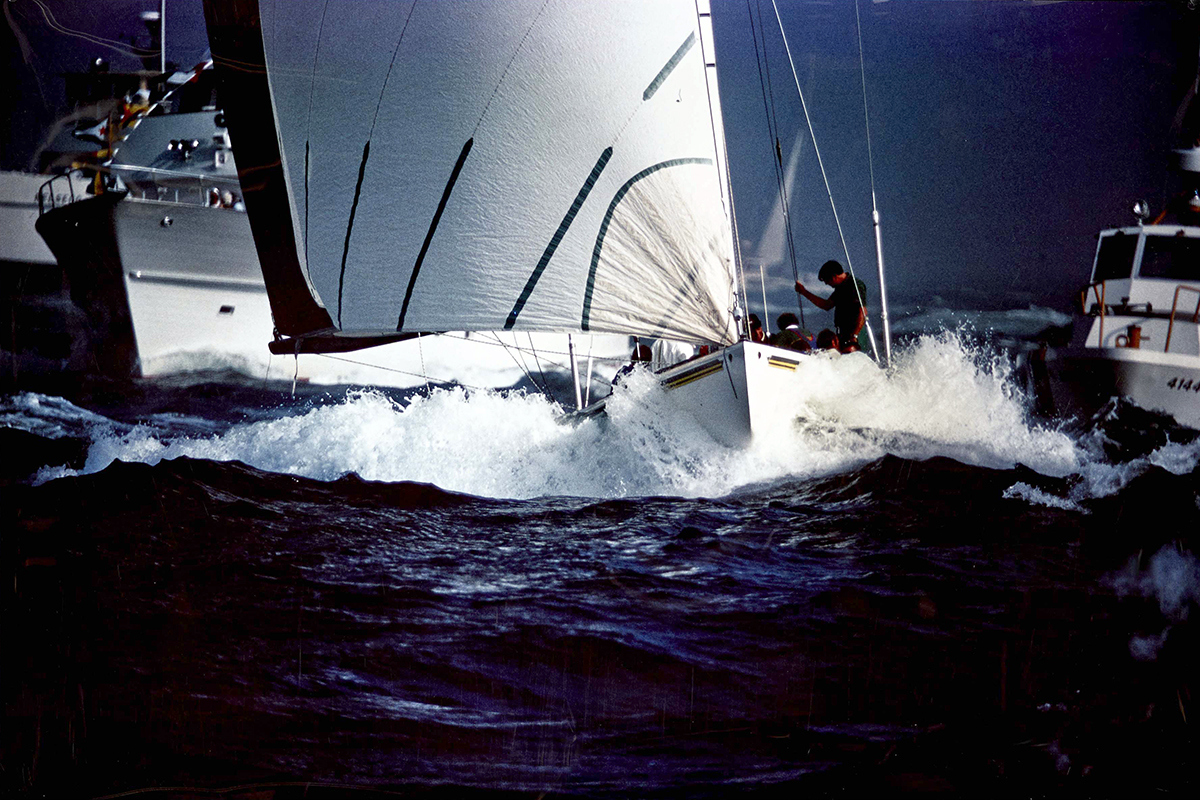
America's Cup AUSTRALIA II ploughing home after a win. ANMM Collection 00000394. Copyright: Sally Samins.
Technical developments
Elsewhere other people became high achievers in their own sailing fields. Local star Iain Murray won six world titles in his self-designed Color 7 18-foot skiffs. Murray went on to become an International champion in other classes. Jon Sanders and Kay Cottee set circumnavigation records with good planning and unwavering determination. Roy Martin, an aeronautical engineer, created Miss Nylex, the first successful wing sailed racing catamaran in the 1970s. Miss Nylex, defended the C Class trophy, while over in Western Australia John Ilett’s work kept the Moth class up on foils consistently. Combine these two innovations and you have wing-sailed catamarans on foils just as they did in the America’s Cup.
![Stern view of Miss Nylex under sail, 1972. ANMM Collection ANMS0280[103], © Mary Martin.](/-/media/anmm/images/blog-content/digital-stories/sailing/anms0280103_800x1200.jpg?la=en)
Stern view of Miss Nylex under sail, 1972. ANMM Collection ANMS0280[103], © Mary Martin.
Lindsay Cunningham optimised the wing sail C -Class further with more victories, then set about chasing down world speed records with Yellow Pages Endeavour. The 50-knot barrier fell to his extraordinary tripod Macquarie Innovation and, for good measure, he used our winds at Sandy Point to break the barrier. Now, they have gone over 60 knots, and that record set in 2012 in Namibia, was created at the hands of an Australian helmsman/pilot Paul Larsen, who once sailed the scow Moths on Port Phillip.
Olympic glory and world records
Gold medals have been secured on many occasions since grandfather Bill Northam steered Barrenjoey to our first in Tokyo in 1964, with youngsters Pod O’Donnell and Dick Sergeant as crew. Two 470 golds, including our first women gold medal winners Belinda Stowell and Jenny Armstrong, were secured on Sydney Harbour in 2000. Three golds and silver were won at the 2012 games in the United Kingdom with Australia dominating the Olympic yachting competition. Much of our recent Olympic success comes down to our coach, Victor Kovalenko.
Paralympic sailing has also achieved its share of medals: four gold, two silver and one bronze since 2000. In fact, Liesl Tesch and Daniel Fitzgibbon won back to back gold medals in the Two Person Skud 18 category at the 2012 and 2016 games.
Women’s sailing has cast its boundaries wide, Adrienne Cahalan went from skiffs on Sydney Harbour to being an Internationally recognised navigator on maxi boats and trimarans.
Australia won the last Admiral’s Cup in 2003 and has won world championships in glamour classes such as the Farr 40s, Etchells, 5.5s, 49ers Lasers, sailboards and catamarans. Our cruising feats include Berimilla completing the Northwest Passage in 2008, and Jon Sanders is still sailing around the world.
Taking Australia on, and taking on board Australians
Australian sailing has moved from taking on the world and gaining much respect along the way, to being taken on board by the rest of the world. It is now universal to see multinational, professional yachting teams and Australians have been amongst the first picked.
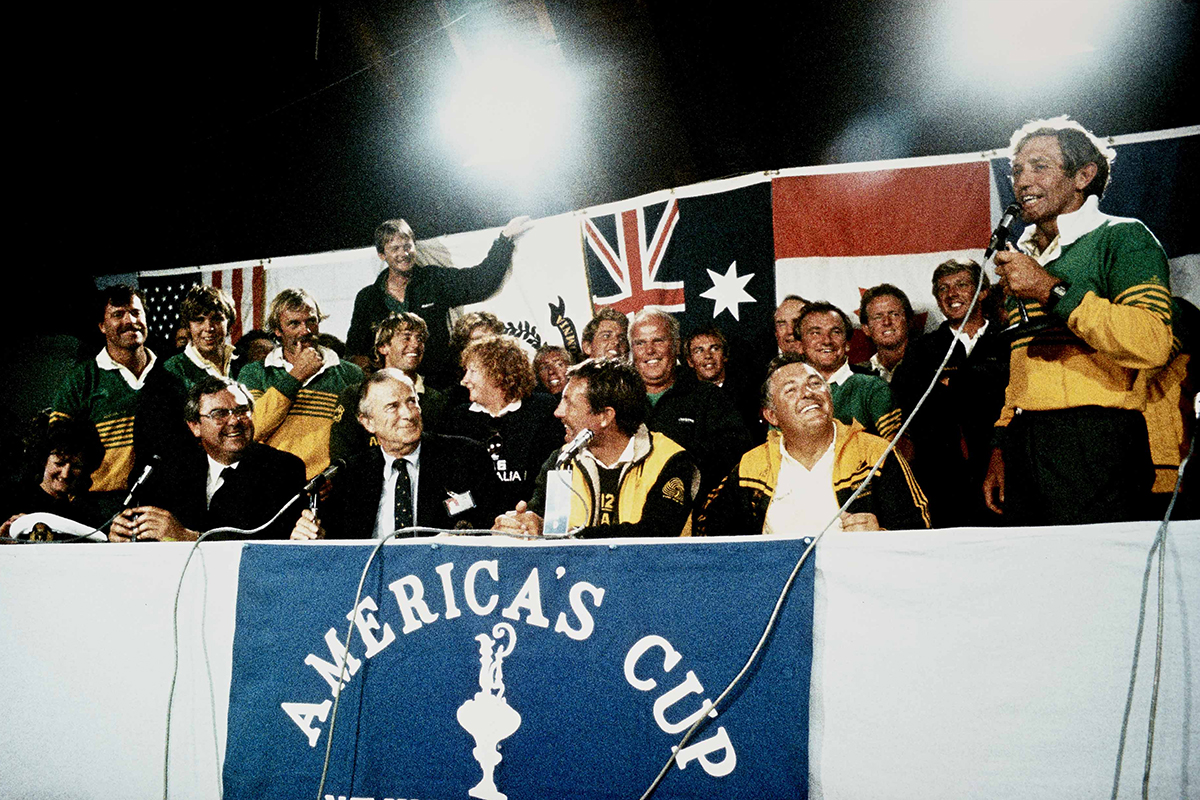
AUSTRALIA II team celebrating victory at the press conference. ANMM Collection 00000407. Copyright: Sally Samins.
It has put us back into the America’s Cup winning circle when Larry Ellison took his chance to match race the Swiss on his terms, his trimaran’s skipper was a brash young Australian Jimmy Spithall, nurtured in the Cup earlier by one of our toughest long term competitors, Syd Fischer. Ellison set new standards for an already over the top spending spree for the defence with his Oracle team, and his design head was Australian Grant Simmer (Australia II’s navigator in 1983). Spithall was the skipper, and all but one of the crew were Australians, so it’s no wonder that it was often called the United States/Australian team. They won under even more extraordinary circumstances than Australia II, but Spithall even with many Aussies on his team, could not repeat this in 2017. However, the victorious Kiwi team had Australian catamaran legend Glenn Ashby as the skipper of their onboard team. Clearly, Australians just can’t be kept out of this race.
If the past is any guide, Australian sailing is in line for many more history-making feats, while the rest of us will continue to enjoy another big day out catching the wind in our sails.
Credits
Further information
Australian Sailing Hall of Fame
The Australian Sailing Hall of Fame (ASHoF) recognises the greats of our sport – those who have inspired many and those who have contributed so much to make the sport of sailing what it is today.
Australian Sailing Hall of Fame

